I want to add select significance marker (preferably with automatic adjustment of spaces) onto grouped boxplots that are created by my ggplot function. This function is structured in a way that accommodates all of my other data, so I'd like to add significance in a way that's compatible to my graphing function.
Here's the sample dataset:
structure(list(Drug = c("Drug", "Drug", "Drug", "Drug", "Drug",
"Drug", "Drug", "Drug", "Drug", "Drug", "Drug", "Drug", "Drug",
"Drug", "Drug", "Drug", "Drug", "Drug", "Drug", "Drug", "Drug",
"Drug", "Drug", "Drug", "Drug", "Drug", "Drug"), Drugcc = structure(c(1L,
1L, 1L, 2L, 2L, 2L, 3L, 3L, 3L, 1L, 1L, 1L, 2L, 2L, 2L, 3L, 3L,
3L, 1L, 1L, 1L, 2L, 2L, 2L, 3L, 3L, 3L), levels = c("0", "60",
"250"), class = "factor"), Tat = c(0L, 0L, 0L, 0L, 0L, 0L, 0L,
0L, 0L, 6L, 6L, 6L, 6L, 6L, 6L, 6L, 6L, 6L, 6L, 6L, 6L, 6L, 6L,
6L, 6L, 6L, 6L), cocaine = c(0L, 0L, 0L, 0L, 0L, 0L, 0L, 0L,
0L, 0L, 0L, 0L, 0L, 0L, 0L, 0L, 0L, 0L, 25L, 25L, 25L, 25L, 25L,
25L, 25L, 25L, 25L), Size = c(145.723, 546.358, 122.951, 555.149,
781.476, 721.454, 521.449, 436.9, 1003.216, 322.241, 1045.689,
596.625, 911.433, 884.375, 882.488, 707.296, 935.018, 830.33,
588.493, 534.274, 922.811, 749.344, 592.114, 878.144, 899.342,
821.622, 822.433), T_c = structure(c(1L, 1L, 1L, 1L, 1L, 1L,
1L, 1L, 1L, 2L, 2L, 2L, 2L, 2L, 2L, 2L, 2L, 2L, 4L, 4L, 4L, 4L,
4L, 4L, 4L, 4L, 4L), levels = c("0 | 0", "6 | 0", "0 | 25", "6 | 25"
), class = "factor")), row.names = c(NA, -27L), groups = structure(list(
Tat = c(0L, 0L, 0L, 6L, 6L, 6L, 6L, 6L, 6L), cocaine = c(0L,
0L, 0L, 0L, 0L, 0L, 25L, 25L, 25L), Drugcc = structure(c(1L,
2L, 3L, 1L, 2L, 3L, 1L, 2L, 3L), levels = c("0", "60", "250"
), class = "factor"), .rows = structure(list(1:3, 4:6, 7:9,
10:12, 13:15, 16:18, 19:21, 22:24, 25:27), ptype = integer(0), class = c("vctrs_list_of",
"vctrs_vctr", "list"))), row.names = c(NA, -9L), .drop = TRUE, class = c("tbl_df",
"tbl", "data.frame")), class = c("grouped_df", "tbl_df", "tbl",
"data.frame"))
Here's a simplified ggplot function:
graphDrug <- function(.data, response, var1, var2, colorFill, color_fill_manual, legendFill, ytitle){
ggplot(.data, aes(interaction(.data[[var1]],.data[[var2]], sep=" | "), .data[[response]], fill=factor(.data[[colorFill]])))+
geom_boxplot(color = "black", alpha = 1, outlier.shape = NA, size=.25, position = position_dodge2(.75, preserve = "single"))+
geom_point(pch = 21, alpha=.7, position = position_jitterdodge(jitter.width = .25))+
scale_fill_manual(values = color_fill_manual)+
theme_classic(base_size = par('din')[1] * 5)+
theme(
text = element_text(face = "bold"),
legend.position = "top",
panel.grid.major.x = element_blank(),
axis.text=element_text(size=rel(1)),
axis.text.y = element_text(angle = 90, vjust = 0.5, hjust = 0.5))
}
fig_name <- "Size" # y-axis title
color_fill_manual <- c("#ffffff", "#A6CEE3", "#1F78B4") # white, blue pairs
with(df, graphDrug(df, "Size", "Tat", "cocaine", "Drugcc", color_fill_manual, "Drug", bquote(bold(.(fig_name)~~(μm^2))))) # Bold y-axis title
This is what I've tried without success:
my_comparisons <- list( c("0 | 0.0", "0 | 0.60"), c("0 | 0.0", "0 | 0.250"),
c("6 | 0.0", "6 | 0.60"), c("6 | 0.0", "6 | 0.250"),
c("6 | 25.0", "6 | 25.60"), c("6 | 25.0", "6 | 25.250"))
p <- with(df, graphDrug(df, "Size", "Tat", "cocaine", "Drugcc", color_fill_manual, "Drug", bquote(bold(.(fig_name)~~(μm^2)))))
p+stat_compare_means(comparisons = my_comparisons, method = "wilcox.test")
This is closest that I came to my desired result, but it's still not what I want:
library(ggpubr)
# Box plots
bxp <- ggboxplot(
df, x = "T_c", y = "Size", fill = "Drugcc",
palette = (values = c(color_fill_manual))
)
bxp
stat.test <- df %>%
group_by(T_c) %>%
pairwise_wilcox_test(Size ~ Drugcc, ref.group = "0", p.adjust.method = "BH")
stat.test
# Box plots with p-values
stat.test <- stat.test %>%
add_xy_position(x = "T_c", dodge = 0.8)
bxp +
stat_pvalue_manual(
stat.test, label = "p.adj.signif", tip.length = 0.01,
bracket.nudge.y = -2
)
Here's the desired result. Although the drawing is crude, I hope you get the effect:

Note about the real dataset:
- There are many different Drugs.
- The x-axis can be more than 3 interaction groups.
- This code and this question are close to what I want, but I can't get them to work.
Thank you for your help.


